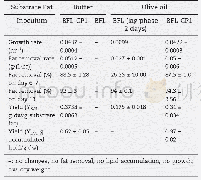《Table 1–Comparisons on NH4-N removal loadings during ammonium-rich wastewater treatment between pre
 提示:宽带有限、当前游客访问压缩模式
提示:宽带有限、当前游客访问压缩模式
本系列图表出处文件名:随高清版一同展现
《Nitrifiers activity and community characteristics under stress conditions in partial nitrification systems treating ammonium-rich wastewater》
After the long-term operation,SBRHand SBRLachieved high efficiencies of nitritation.In SBRH,the effluent NH4-N concentrations were less than 5 mg/L,and the concentration of NO3-N was 5.99 mg/L.Accordingly,the NH4-N removal efficiency was 99.8%,and the nitritation efficiency(NO2-N to the oxidized nitrogen (NOX-N)ratio) was 99.3%.Influent NH4-N concentration of SBRLwas around 335 mg/L.After the 28-day operation,SBRLreached steady state,and the effluent NH4-N concentrations were below 1 mg/L;the NO3-N concentrations were less than 15 mg/L.Accordingly,the NH4-N removal efficiency was 99.8%,and the nitritation efficiency was 95.7%.At the steady states,MLVSS of SBRHand SBRLwere3.45 and 2.25 g/L,respectively.Table 1 shows the comparisons of the NH4-N removal loading rates of the present systems treating ammonium-rich wastewaters with some of previously reported systems.The NH4-N removal loading rate obtained in this study was higher than those from most previous studies in Table 1,i.e.,less than 1.0 g/L/day.However,Toràet al.(2014)applied continuously feedback control loops treating ammonium-rich wastewater and obtained the NH4-N removal loading rates of 3.6–6.7 g/L/day,which was much higher than the NH4-N removal loading rates obtained in this study.The loading rates in this study could be further increased through(1)improving MLVSS(such as cultivating granule sludge),(2) shortening the duration of the settling phase and(3)increasing DO concentrations during the reaction phase.Further investigations should be carried out to evaluate these effectiveness in this field.
| 图表编号 | XD0025354500 严禁用于非法目的 |
|---|---|
| 绘制时间 | 2018.11.15 |
| 作者 | Jia Miao、Qidong Yin、Tomoyuki Hori、Tomo Aoyagi、Hiroshi Habe、Guangxue Wu |
| 绘制单位 | Guangdong Province Engineering Research Center for Urban Water Recycling and Environmental Safety,Graduate School at Shenzhen,Tsinghua University、Guangdong Province Engineering Research Center for Urban Water Recycling and Environmental Safety,Graduate Sc |
| 更多格式 | 高清、无水印(增值服务) |





